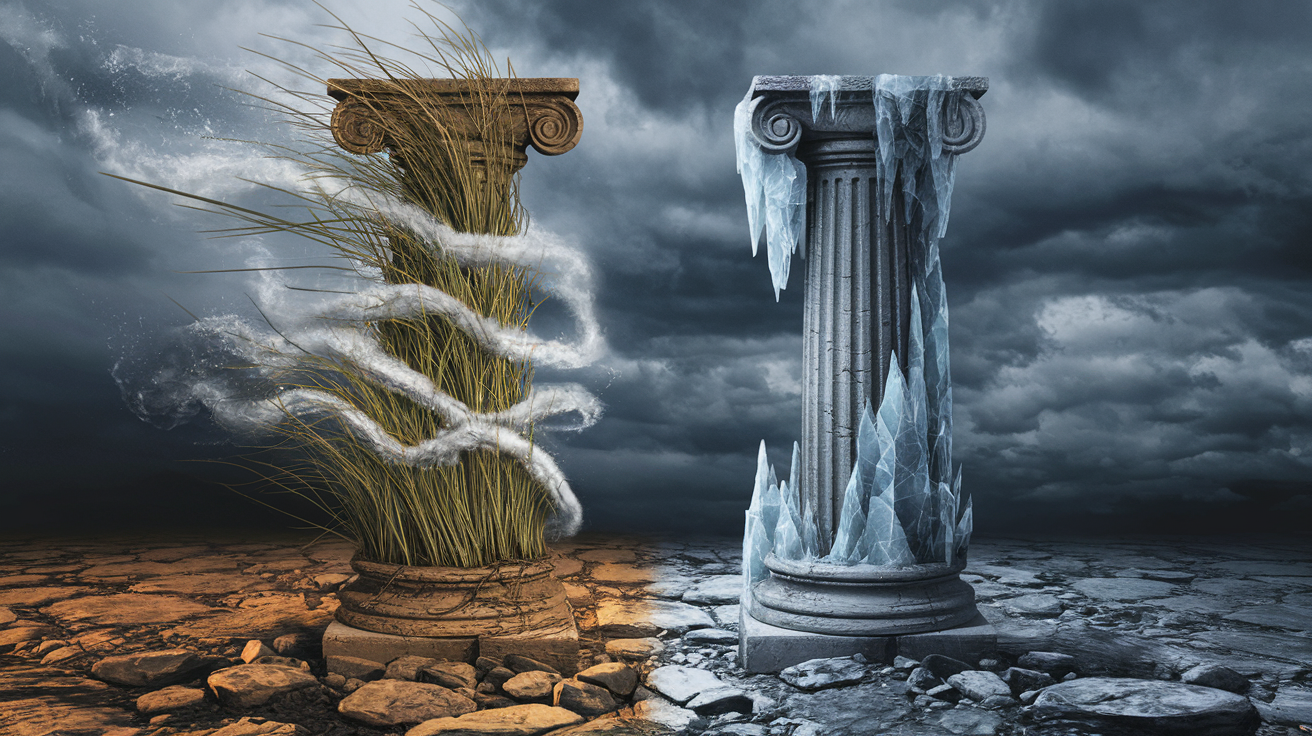The Great Maryland Bacon Crater
How Organizations Create Their Own Crises
Every leader encounters problems, but not every problem needs to become a crisis. Knowing how to accurately categorize and respond to issues can save organizations from costly mistakes and protect their reputation. Throughout my career, I’ve been on both sides of the conversation that starts like this:
“Hey boss, we’ve got a problem here.”
“Don’t come to me with problems; come with solutions!”
Leadership gurus on LinkedIn love this exchange. They’ll dissect the boss’s tone and posture while reminding employees to show up ready with answers. There’s some utility there—but it skips the most important first step and launches straight to the endgame. I used to dread delivering that first line. After years of learning the hard way, I’ve retired that second line from my vocabulary altogether. These days, my response is simple:
“What kind of problem is it, and is it even ours to solve?”
The world is chockablock with problems of all kinds, and it’s crucial to classify them correctly. People, news agencies, governments, militaries, and corporations often use terms for different kinds of problems interchangeably, creating layers of confusion. I recently reviewed a corporation’s risk management plan that listed four levels of crises—ranging from a local crisis to an international crisis—but none of those situations were causally linked to the organization itself.
It’s not that naming problems is new. But only in the last couple of decades have industry, government, and academia begun to settle on shared definitions. Following Hurricane Katrina articles emerged discussing how problems were classified across support organizations and the government. By the time COVID arrived, the language was finally starting to stick.
Types of Problems: From Issues to Catastrophes
Problems escalate based on the level of support required. Let’s take a Groundhog’s Day-esque journey through them to see what we can discover.
"Rise and shine, campers!"
I’m, admittedly, a terrible cook. I have a nasty habit of “multitasking” which is watching videos on my phone while the breakfast burns. Every morning I make bacon and start a grease fire. Luckily, I’m prepared. I keep a bucket of sand under the counter. I grab the bucket, douse the fire, and—gritty or not—eat my bacon. My family, used to sight of a sandy stove and uninspired by the taste of soot declines breakfast. I apologize, clean up, and buy them breakfast. Problem handled. It was an issue laden morning but I made it through it. High-five-myself-no-friends!
An issue is any trend or development—real or perceived—at least partly in the public arena, which, if it continues, could have a significant impact on the organization’s financial position, operations, reputation, or future interests. Issues require a structured response.
"Ned… Ned Ryerson!"
Same morning, same bacon, same wonderful fire. Man that Smosh crew really gets me going. Shayne is a cutup. This time I grab the sand bucket and out tumbles water?!? I must have grabbed the wrong bucket. Someone keeps moving those buckets next to each other and it isn’t me. Now the kitchen’s fully ablaze. I call the fire department. They know me by name. The emergency’s bigger than me but not world-ending. Another apology, another breakfast run, and another call to insurance.
An emergency is an abrupt event that impacts an organization locally, beyond its scope to resolve with internal resources alone, and calls for immediate action. These events carry low potential for adverse impact beyond the initial event. Emergencies may develop gradually from issues when local resources are outstripped and external support is required.
"Don’t drive angry."
Kitchen’s on fire again. This time, when the Pierce Type 1 fire engine arrives, it’s 40,000lbs find a weak point in the road which causes a crack. That crack shifts a piece of shale, exposing a natural gas pocket. The pocket ignites immediately, turning my entire subdivision into a smoldering crater the size of Central Park. News of this
“Great Bacon Crater” reaches far and wide. FEMA is the lead federal agency on scene for weeks, and the National Guard from six states is deployed in a joint cleanup and humanitarian assistance effort. Vigils are held every year. After a respectable number of years, Guy Fieri builds a bacon palace on the rim earning a well-deserved Michelin star.
A disaster is a major, abrupt adverse event that affects broader society. Disasters outstrip the response capabilities of both local and regional responders. They may develop from emergencies when resources are exhausted at the agency and regional level, requiring coordination at the interagency and national level.
"I Got You, Babe."
The fire truck rolls up yet again, the pavement cracks, and for a brief moment, the gas and the fire haven’t found each other. I’m on the porch holding a boombox above my head, wearing a trench coat and sunglasses —“So put your little hand in mine…”
The explosion that creates the Great Bacon Crater also hurtles a boulder from the neighbor’s koi pond into low-Earth orbit. It slams into the International Space Station, triggering a chain of debris that eliminates telecommunications for 60% of the world in minutes. Foreign skies fill with the streaking remains of satellites burning up on reentry. Keys are turned, buttons are pushed, some farmland begins rumbling, and we have the beginning of a real catastrophe.
A catastrophe is a major adverse event that affects a nation or multiple nations, potentially depleting all available resources and requiring enduring lifestyle changes. Catastrophes can develop from disasters when resources at the national and interagency level are fully outstripped, requiring extraordinary or international support.
“One perfect day”
Maybe I’ll skip breakfast entirely and figure out what a crisis really is. This is where most people stumble. Ask anyone to define a crisis, and you’ll hear the usual: a major disruption, a sudden event requiring an urgent response. Everyone nods along. Sounds about right.
Except it’s not. Or at least, it’s incomplete. That definition tricks leaders into thinking crises simply “happen” to them, like getting caught in a thunderstorm. But that’s not how it works.
If that were true, every organization hit by the same event would suffer equally. We know that’s not what happens. Some companies navigate the storm. Others get wrecked. The difference isn’t what happened—it’s how they handled it.
Here’s the truth: A crisis isn’t the event. A crisis is what happens when the event is mishandled and then the mishandling is mishandled and the mishandling of the mishandling is mishandled. I’m not even joking. Organizations will dig and dig just searching for the bottom because they are looking for ways to stop the crisis and that’s just not how crises work.
You can light your kitchen on fire and walk away just fine if you call the right people, own the mistake, and fix what you can. What creates a crisis is when you dodge responsibility, point fingers, and erode trust.
For instance, if bacon-burning me didn’t apologize to my wife right after the fire was out for setting our house ablaze and instead explained to the fire depart how someone *ahem-not me-ahem* put the water bucket near the sand bucket, that might create an issue. Then when she brings it up later maybe I try little light gaslighting to shift focus from the issue. We can already see my metaphorical shovel hard at work.
Now I have fire damage and trust relationship damage. This is a simplified example, but we’ve seen this example play out across airlines, governments, pizza delivery services. Industry to industry the model is the same. What is driving this behavior?
An organization’s first instinct is to protect itself. I know what you’re thinking, how do organizations have instincts? Well, organizations are people and the very first behavior a person ever displays is a startle reflex. It triggers your very first breath and is based on self preservation. You were scared into breathing on your own. After that, it’s just one problem after another. We’re problem solving machines and leaders of all stripes make their livelihood by solving problems. Their first instinct is: How do we fix this? What’s the answer? What’s the solution?
That’s fine for operational issues. But it’s a trap when you’re managing trust.
"Trust is earned in drops and lost in buckets," the old adage every crisis professional lives by. The crisis professional is checking if the floor is wet and thinking in terms of what must we do right now to show control, competence, and care? The bucket and the solution are two wildly different things. You can tip the trust bucket all the way over and lose all your trust if you go about finding your solution the wrong way. Better to steady the bucket and then address the problem. You can’t always fix everything but you can always show the public you’re the kind of organization that does the right kinds of things when things go wrong.
Leaders solve problems; crisis professionals reduce crises. Problem-solving is technical; crisis management is relational. Lead as though every problem has a simple fix, and you'll overlook the crucial moment when real damage moves from operations to your reputation. That’s how minor fires escalate into five-alarm disasters—how simple issues turn into the crises you create. At Information Advantage LLC, we teach leaders to spot this shift. Because in crisis, solving the problem is optional, but preserving trust is mandatory. Don’t let a bit of bacon become the crisis you create.



